Overview of grape diseases and treatments

Grapes are one of the most popular summer cottage crops. It is grown by both professionals and amateurs. When cultivating grapes, it is important to recognize various diseases in time and neutralize pests. You will learn how to do this correctly in this article.

What's damaged?
If a grape is exposed to any disease or insect, this always affects its appearance.
Both individual parts of the plant and the entire culture can suffer.
Kidney
Grape buds are usually the most affected by leaf-eating parasites. These are mainly scoops, kravchiks and skosari beetles. Also, on shoots with damaged buds, special holes with raised edges may appear. This means that the grape is attacking the stem cricket.


Leaves
Leaves always suffer the most, and many diseases are immediately recognized by them.
Some of the most common types of leaf damage are:
- galls (thickenings) of a rounded shape, located at the bottom of the leaf plate, indicate the presence of phylloxera;
- flat tiny galls indicate the presence of a grape mite;
- small yellow spots with an orange tint appear when a spider mite parasitizes on the culture;
- an uneven yellow tint of the foliage (the veins are green at the same time) will indicate the presence of chlorosis;
- yellow / red edging of the leaves means that the plant has jaundice / rubella;
- the first sign of oidium is a gray coating;
- oily spots, white underneath, are almost always a sign of mildew;
- dark red spots with black specks - the result of the appearance of black rot;
- gray-purple spots indicate anthracnose;
- deformation, underdevelopment, strange leaf shapes are signs of viral ailments.


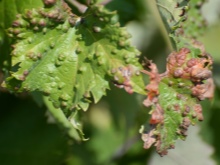
Inflorescences
Inflorescences of grapes are infrequently affected, therefore, in most cases they remain intact. But a few modifications can still occur. For example, white, like a felt coating, will tell about the presence of a grape mite. A mealy coating that looks like flour is the result of mildew exposure.
The presence of cobwebs, silk threads is a sign of the appearance of various caterpillars.
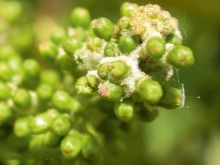

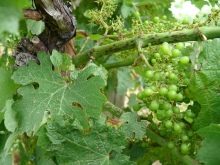
Berries
Damage to berries mainly occurs in the presence of fungal diseases:
- if it is oidium, then the clusters will crack and become covered with a gray coating;
- black spots, as well as wrinkled peel, indicate black rot;
- mold on young green berries is a sign of gray rot;
- ulcers will indicate anthracnose;
- if blue-brown spots appear on the clusters that have just begun to actively grow, this will mean a sunburn.
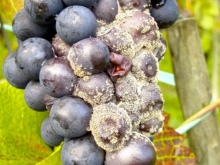
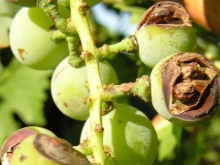
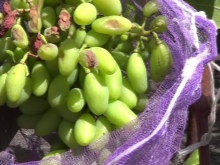
Diseases and treatments
If the grapes are grown in the wrong region or climate, they receive less care and attention, then they will quite often be affected by various types of diseases. Consider what gardeners have to deal with.
Mildew (downy mildew)
This is a fungal disease that affects all parts of the plant: from antennae to leaves and bunches. The causative agents of the disease hibernate in the soil, they are especially dangerous during showers, high humidity. If the air temperature is above +8 degrees, and the soil is wet for a day, the spores begin to germinate. Infection occurs after the incubation period. At temperatures from +20 to +26, it will be only 4 days.
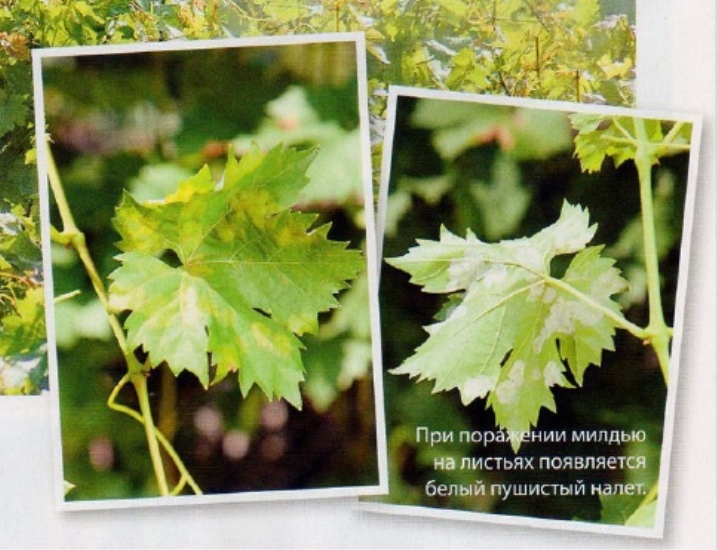
The symptoms are as follows:
- yellow or rusty spots on young foliage;
- necrotic spots with a whitish coating in the lower part of the leaf plate;
- drying and yellowing of inflorescences;
- wrinkling of berries.

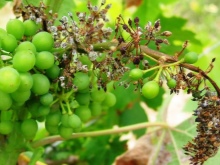
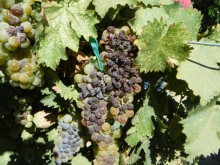
The size of the spots will depend on the resistance of the variety to mildew. Highly resistant varieties will have a diameter of 1-2 mm, while susceptible varieties will have large spots with abundant sporulation.
The fight against mildew is carried out at the following frequency.
- The affected parts are cut off and burned.
- Before and after flowering, preventive treatment is carried out (highly resistant varieties do not need it). The best drug is Ditan Neotek. The dosage is 3-4 kg per hectare. Before flowering, you can also use "Acrobat", "Ridomil Gold". After - "Topaz", "Vectru". For the last treatment in August (5-10th day), it is recommended to apply "Quadris".
- In the fall, when the leaves fall, you can spray the culture with 1% Bordeaux liquid.
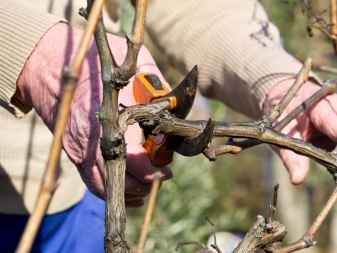
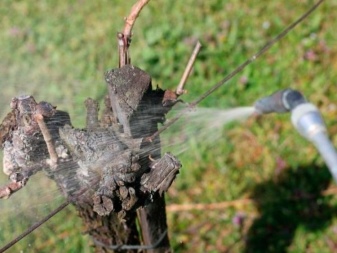
Oidium (powdery mildew)
Oidium is another dangerous disease that often affects grapes. All parts of the plant are affected.
Symptoms:
- at the initial stage, small greenish specks with a matte surface appear (they can still be gray);
- a little later, a pronounced mealy bloom appears;
- leaves dry up and die;
- longitudinal dark spots are visible on the shoots;
- the skin on the grapes dries up, cracks badly, the berries burst.
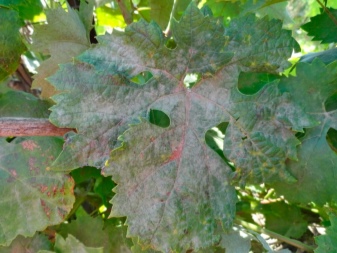
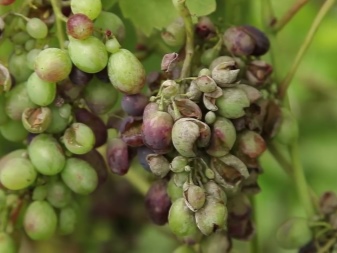
The immediate moment of infection is difficult to determine, but when spots appear, you need to urgently act.
Every three years, gardeners recommend using the drug "DNOC". It is diluted in water (100 grams per 10 liters). As a preventive measure, fertilizers with phosphorus and potassium, colloidal sulfur are used. In case of infection, only fungicides will help, for example, "Strobi", "Topaz".
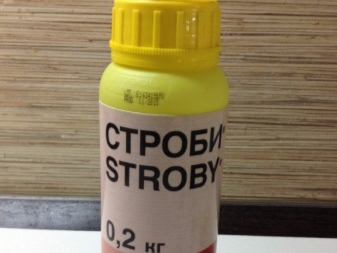
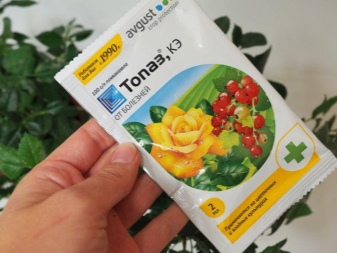
Rubella leaf
This is another fungal disease that often affects grapes. When a plant gets sick, yellow spots with a green tint appear on its leaves. The veins turn brown. After a short time, the stains begin to dry. If the berries are white, the spots will be brown and the border will be yellow. Red varieties are characterized by brown spots with a red tint with a purple border. The berries ripen slowly, the bushes grow poorly, they have a great chance of winter freezing.
Rubella is treated with fungicides. The same preparations are suitable as for the fight against mildew. The first spraying is carried out when there are already 3-4 leaves. The second is before flowering, the third is after.
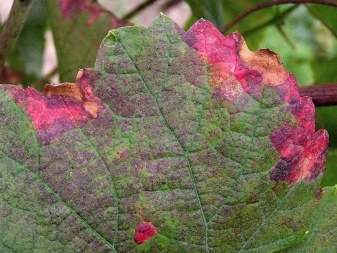
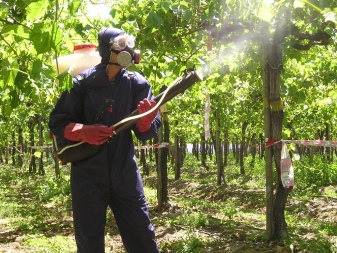
Chlorosis
Chlorosis is a rather controversial disease, which can be caused by several factors at once. It can be non-infectious and infectious. The first appears if the grapes grow on too alkaline soils, as well as in cases where the grower uses too much ash for fertilization. Leaves turn yellow, discolored, shoots dry. Infectious chlorosis is also called mosaic. The leaves turn yellow along the veins, acquiring an uneven yellow-green color, they become small, deformed. The bunches are underdeveloped.
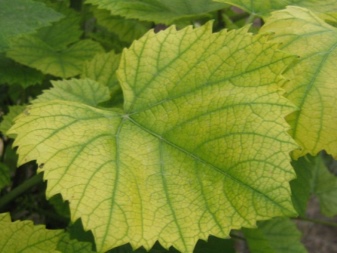
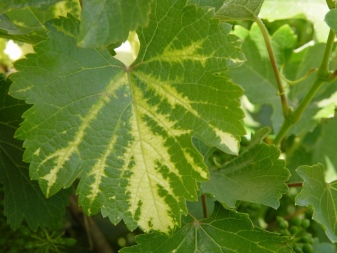
Treatment will depend on the form of the disease. In the case of a non-infectious option, you should tackle the soil. You can use iron sulfate by mixing it with 20 g of citric acid and dissolving in 10 liters of water. One bush will require 10 to 40 liters of liquid. In addition, a drug such as Fetrilon should be used. If the grapes are grown on heavy soil, frequent loosening and composting are used.
Infectious chlorosis is not cured. It is a very rare disease that cannot survive the winter. If it still showed itself, you will have to uproot the diseased bushes.
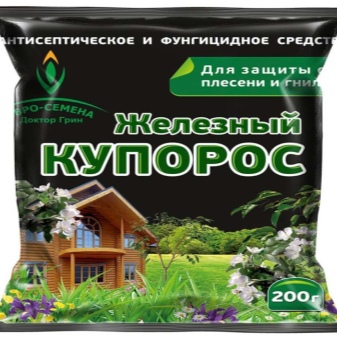

Necrosis
This disease is characterized by the appearance of black dead areas on the plant. Necrosis can be caused by bacteria, viruses. The sleeve of the bush dries up. As for the treatment, it should be noted that viral necrosis cannot be cured. Stains cannot be removed, because this is already dead material. You can try to clean them using iodine or potassium permanganate. But in many cases this will not give much result.
The only possible ways to combat are preventive. Use healthy cuttings, decontaminate inventory. Cuttings are placed for storage only after processing with copper sulfate. It is also important to use the correct covering material.
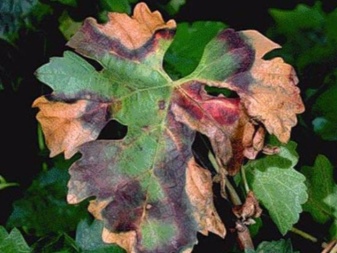
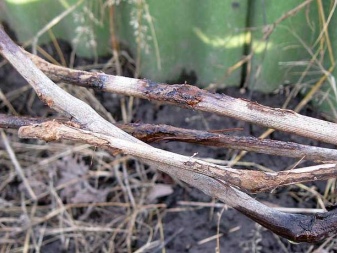
Bacterial cancer
The disease is dangerous in that it can only be recognized by the middle of the growing season of the bush. A white tumor appears on the plant, which grows rapidly. Very often, tumors arise in places that were previously injured.
There is no cure for this disease. It is only necessary to observe prevention, choosing healthy cuttings and disinfecting the instrument in time. The affected bush is dug up.
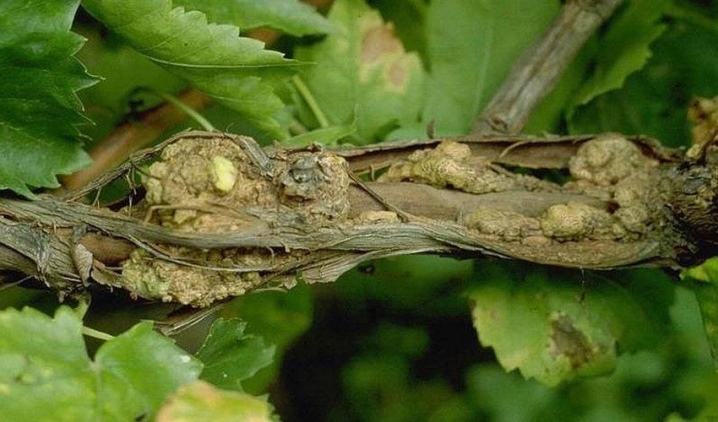
Anthracnose
Anthracnose attacks the clusters as well as the green parts of the crop. It is characterized by gray spots with a brown border (on the foliage). Holes soon appear in their place. The spots can also be seen on the shoots, where they are brown. As for the bunches, here the formations are purple in color.
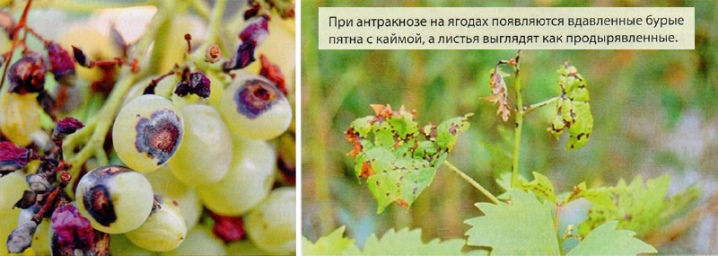
Treatment is carried out with strong fungicides, the same ones are suitable as for mildew. All affected parts are removed.
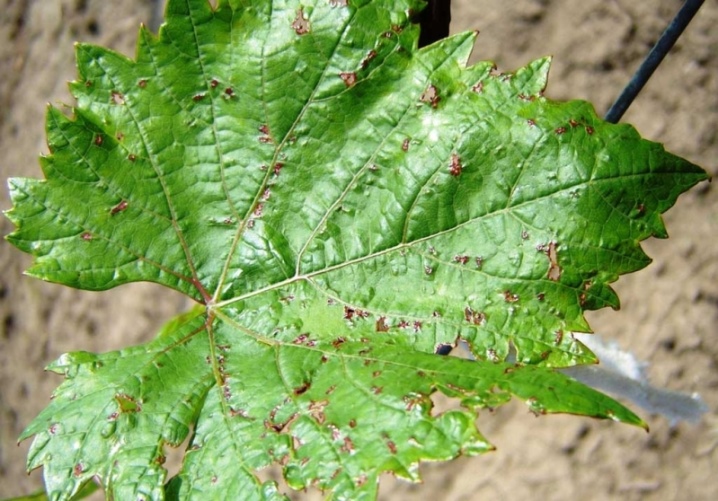
Gray mold (gray mold)
Some signs of the disease:
- large spots with a light border on the foliage;
- the presence of spores and white pollen;
- drying of inflorescences, their brown tint;
- deformation of berries and plaque on them.
Treatment is often ineffective, but you can try. Spraying is carried out with such preparations as "Switch", "Horus", "Antracol". There will be several procedures: before flowering, at the end of the growth of berries, at the time of softening of the bunches.
For prevention, the trunks should be raised so that the clusters do not touch the ground.
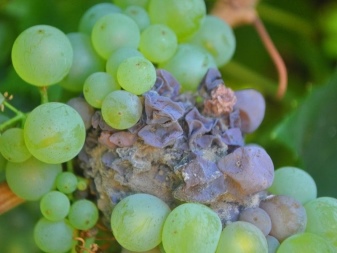

Black rot
It begins to progress in early summer. First, small reddish spots appear, then they grow and brighten. Disputes are clearly visible, passing even to berries.
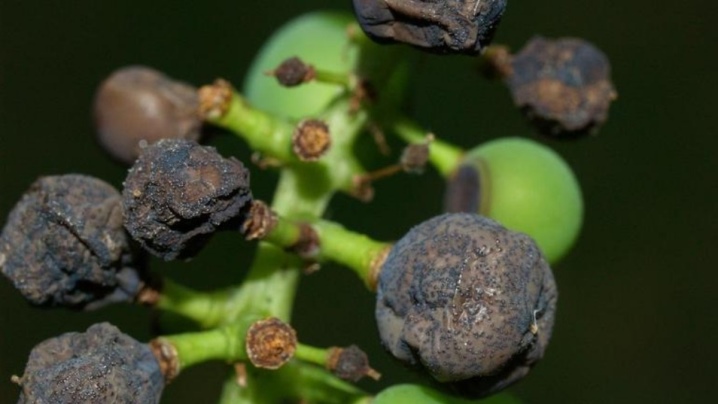
When an ailment is detected, diseased specimens are immediately removed, the remaining bushes are sprayed with Antracol, Topaz. In the spring, they are treated with 2% Bordeaux liquid.


White rot
It is very common in regions where hail is normal. Berries wrinkle, dry quickly, turn brown. Branches are covered with brown spots, and shoots - bloom.
Damaged specimens must be removed, as they contain fungus. Then they are treated with drugs intended for the treatment of mildew.
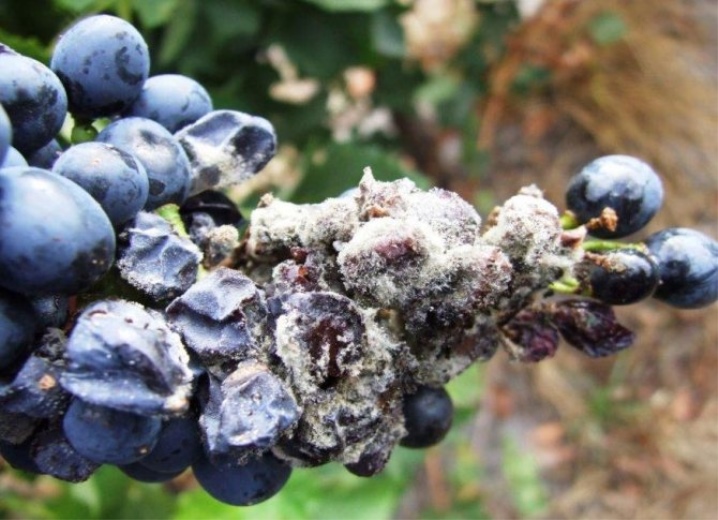
Black spot
The whole plant is affected. Green spots appear on the leaves, which quickly darken. Soon, such a sheet is torn. Black longitudinal lines appear on the shoots. The shoot weakens, it can break from the wind. The berries dry, fall off, mummify.
It is almost impossible to treat such an ailment, disputes penetrate so deeply. Prevention will help:
- at the end of autumn, grapes are treated with copper sulfate (3%);
- in the presence of 3 leaves and almost half of the blossoming buds, the culture is sprayed with the preparation "Ridomil Gold";
- when flowering, use "Quadris".
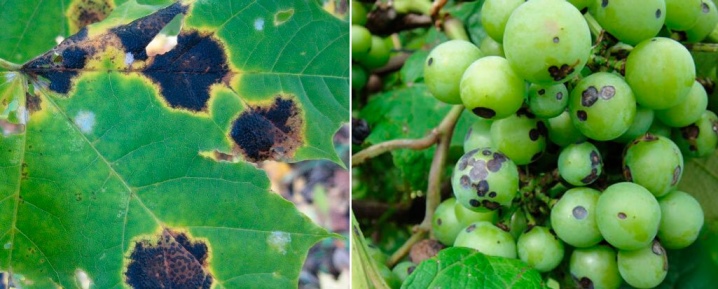
Common pests and control
Besides diseases, any grape variety can be attacked by pests. Consider the most common insects that parasitize vineyards.
Grape blower (weevil)
Green shiny beetle with a body length of 10 millimeters.

Rolls the leaves of grapes (which subsequently dry) and lays eggs in them, from which voracious larvae hatch, eating all parts of the bush. The pest can be removed if the soil is well dug in the spring. In case of dominance, use "DNOC".
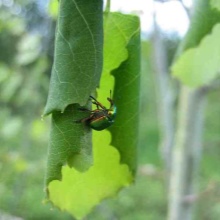
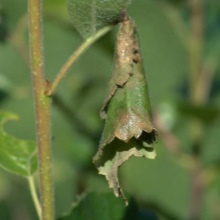

Phylloxera
A popular pest capable of infecting the leaves and roots of the crop. Parasitizing the foliage, it pierces it with the proboscis, provoking the appearance of dark pimples.
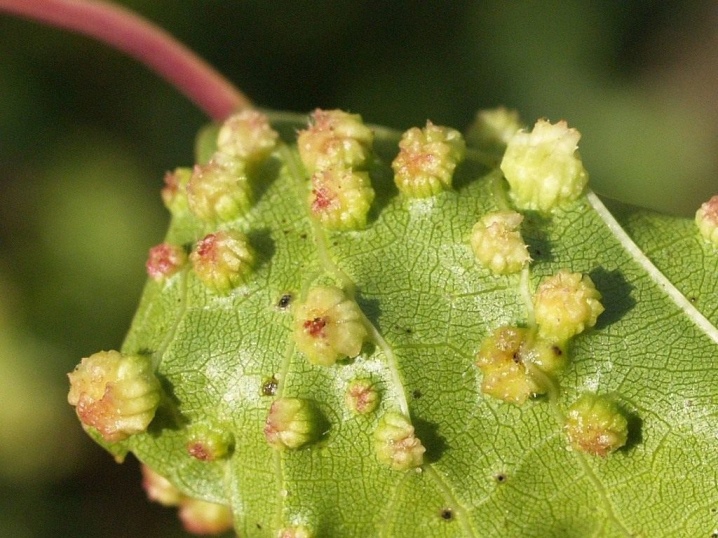
The insect is a small yellow aphid. Before wintering, it lays eggs, so it can harm for years. The bad thing is that the treatment gives almost no results, since the drugs are extremely toxic.
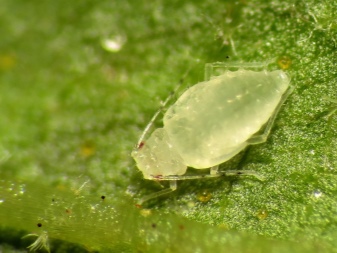
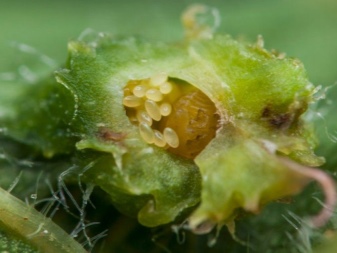
The only protection option is vaccination. The affected leaves should be cut off and burned, the remaining parts should then be sprayed with insecticides. You can use "Confidor" and similar insecticides.
Khrushchi (May beetles)
The beetles themselves do not pose a danger to grapes, but their larvae are extremely gluttonous. They live in the soil for several years, feeding on roots and causing the death of plants. To find them, you need to regularly loosen the soil.

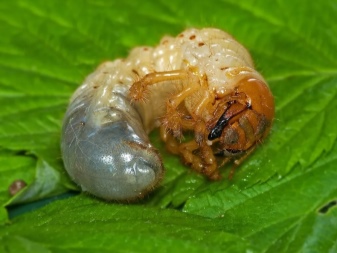
Of the drugs, "Aktara" and "BI-58" will give good results.
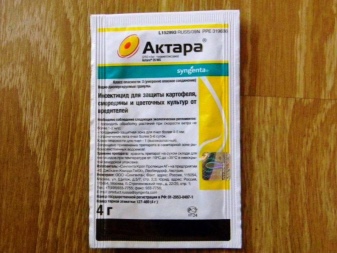
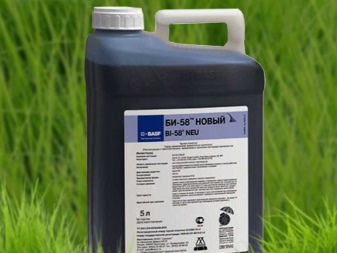
Spider mite
A tiny spider-like creature of yellow color. Lives on the lower part of the leaf, feeding on its juice.
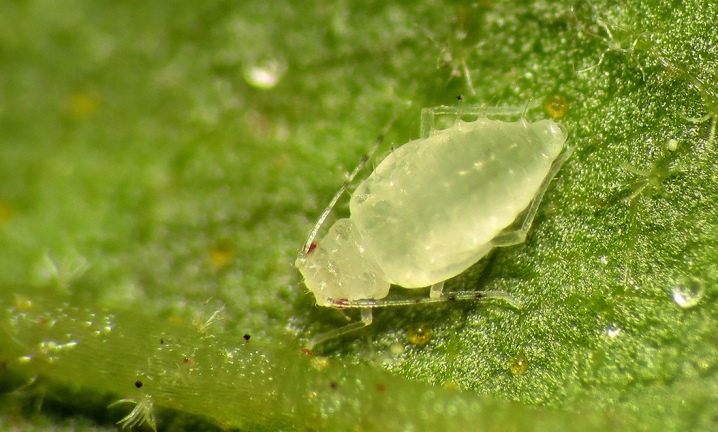
The foliage turns yellow, then turns red and falls off. The grape loses its taste and stops growing. It is necessary to get rid of the tick with preparations containing sulfur. Do this at least a week before bud break. If the insects are very prolific, acaricides should be used. Apollo and Ortus will cope well with this task.
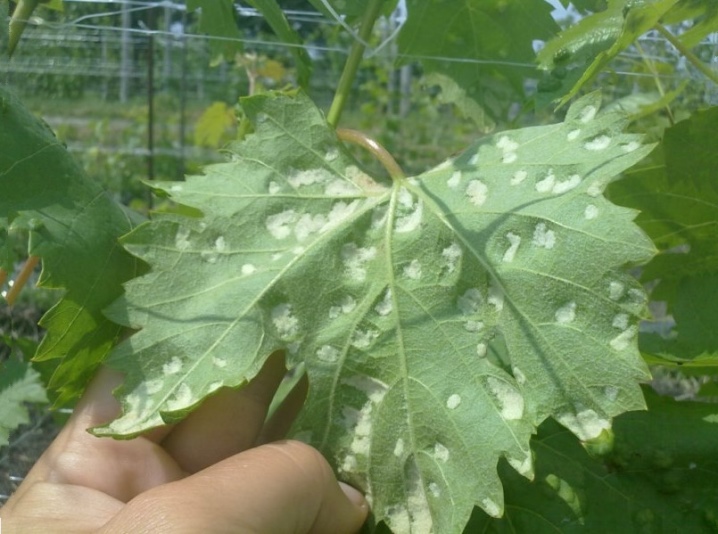
Grape felt mite (itch)
An insect so small that you can't see it. Dwells on leaves. It is characterized by the appearance of pimples on the upper part of the leaf plate. In the lower part there will be small indentations, covered with a bloom resembling felt. If you do not fight the parasite, it will spread to other parts of the plant.
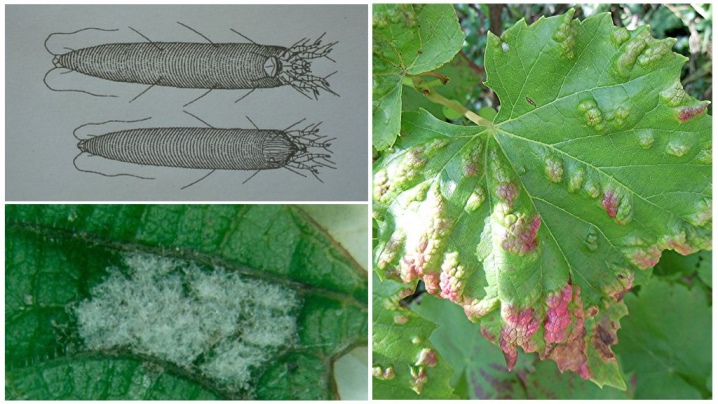
In treatment, pollination with powdered sulfur will give a good result. In addition, the tick will not appear if prophylaxis against downy mildew and common powdery mildew has been carried out.
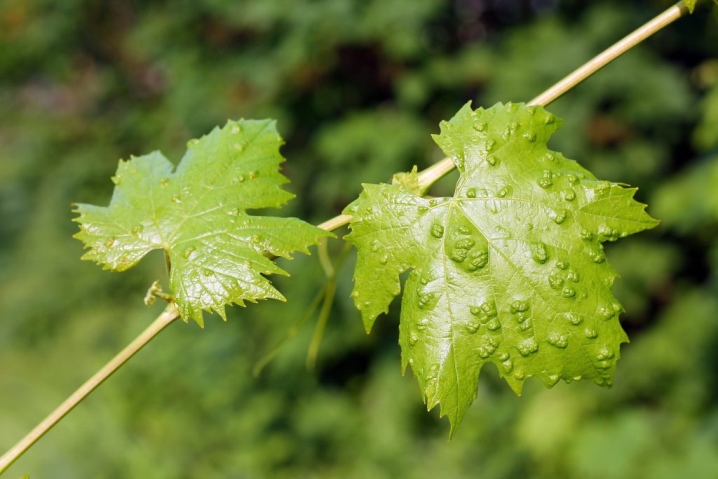
Grape leafworm
Small dark brown butterfly with spotted or striped wings. The caterpillar is green, with a black head. The parasite eats absolutely all parts of the plants, which from this begin to rot. In the absence of a struggle, the harvest will be lost. For treatment in winter, the stem is cleaned of exfoliated bark, the bark itself is burned. This is followed by the treatment of the soil and bushes with the drug "DNOC".
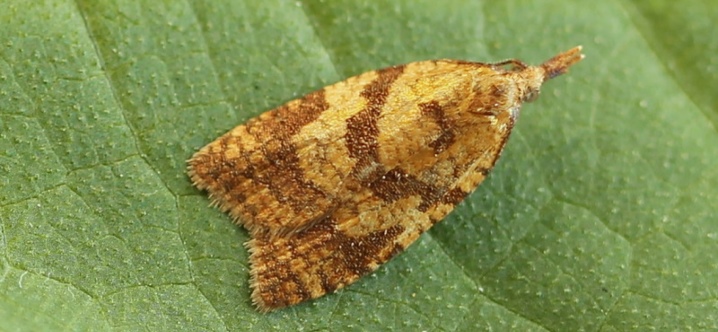
Bunchy leaflet
A small spotted butterfly with blue specks on its wings. The parasite's caterpillars eat buds, flowers and berries. The pest regularly breeds, bringing out new generations. You can get rid of them with a chlorophos solution (20-30 grams are dissolved in a 10-liter bucket of water). This must be done 2 weeks after the appearance of butterflies of the 1st and 2nd generation.
It is also recommended to use pheromone traps.
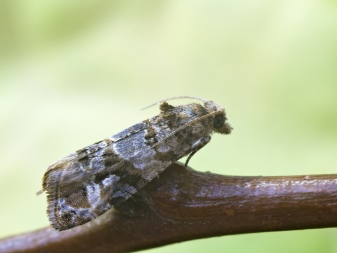
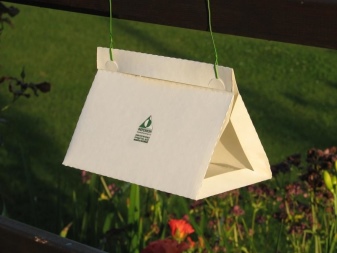
Grape mealybug
A tiny oval parasite, covered in a white cannon. It feeds on leaves, flowers, berries and shoots. The affected parts dry out quickly, wrinkle. For the fight, it is important first of all to clear the bark and raise the stem. Treatment with benzophosphate will also help.
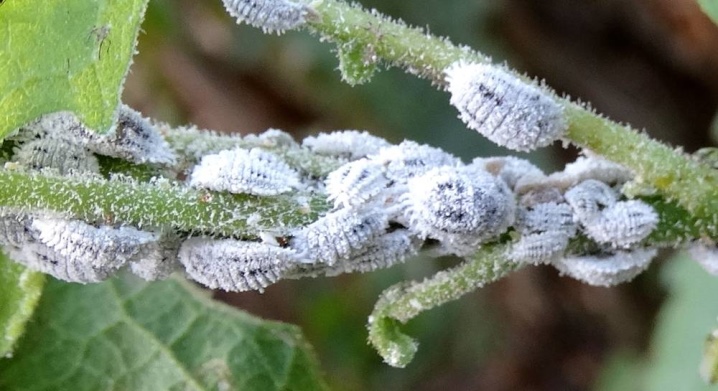
Corn dung
It is a dark brown or black beetle up to 24 millimeters long. Lives in the soil. The larvae that are born actively gnaw the roots, leading to the drying out of the plant.
You can get rid of the parasite by digging the soil. In this case, the beetles are collected by hand.
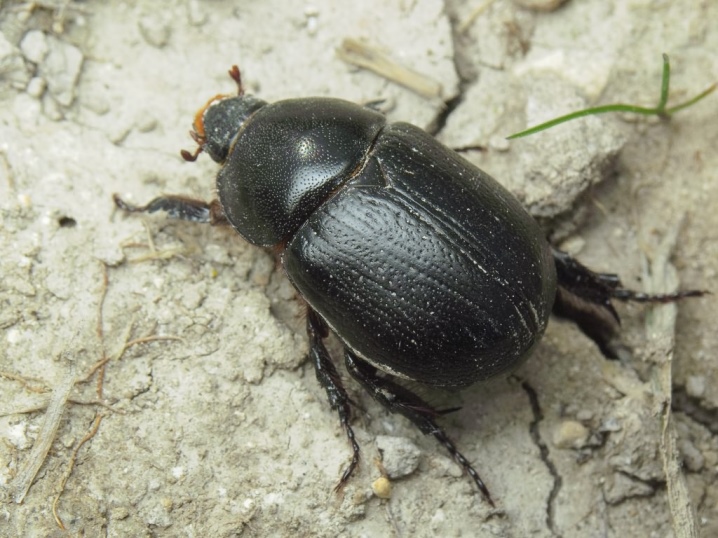
Grasshoppers
Grasshoppers love to eat leaves, shoots, and buds. Insect larvae overwinter in the ground. To prevent the parasite from appearing, the vineyard must be well looked after by removing weeds. Traps can be set between the rows, and then the captured insects can be manually collected. You can also use drugs. The same remedies are suitable as for the Colorado potato beetle.
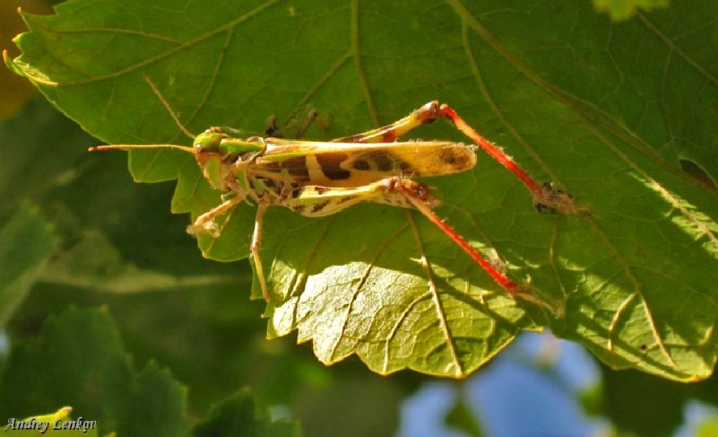
Winter scoop and wireworm
The winter moth is a grayish butterfly. The caterpillar is green. Both the adult insect and the caterpillar parasitize at night. The wireworm is the larva of the click beetle. It has a hard body of yellow or reddish color, parasitizes on all parts of the plant. To fight it is required to use soil digging, liming. It is also important to control weeds. "Actellik", "Decis" will also help. Own-rooted seedlings do not spud.

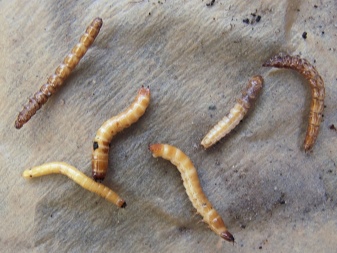
Turkish Skosar
A small black beetle that damages the kidneys. It parasitizes at night, also feeds on roots. When a pest appears, the bush is sprayed with a 0.5% chlorophos solution.
You will need to put rings with caterpillar glue on the sleeves of the grapes.
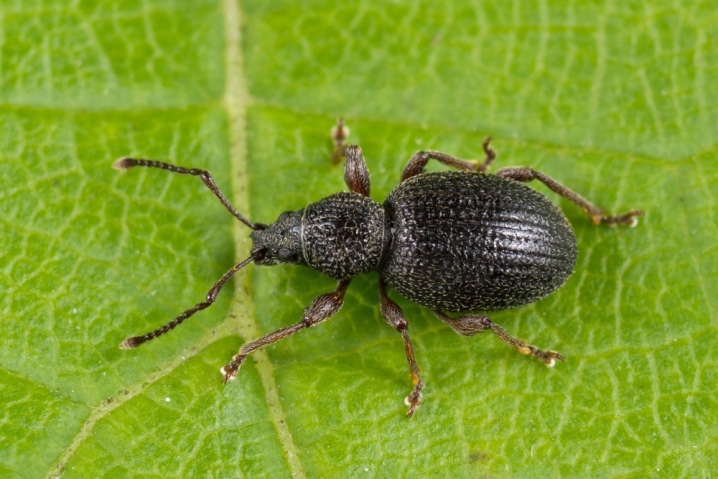
In addition to the described pests, grapes can also attack:
- wasps;
- scabbards;
- bear;
- cicadas;
- birds;
- mice.
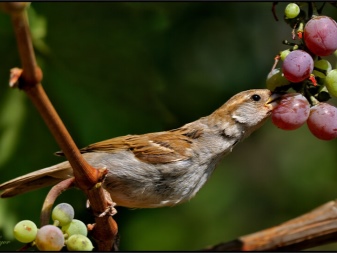
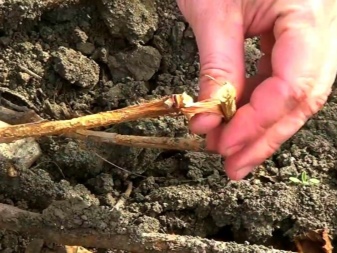
Prevention measures
Carry out preventive treatment of grapes with special preparations annually.

In order for the grapes to be exposed to diseases and pests as little as possible, the correct preventive measures should be taken.
- Locate vineyards in sunny locations. Ventilation should be moderate and the soil should be fertile.
- For planting, choose healthy seedlings, carry out pre-planting processing. If grapes are grown from seeds, they are pre-soaked in boric acid for 12 hours.
- If you can't get rid of any disease, plant the grapes elsewhere. At the same time, select the varieties that are most resistant to this disease.
- Take proper care of your vineyard. Loosen the soil, water in a timely manner, remove weeds. Conduct a visual inspection of the bushes.
- Fertilization is also very important. In the spring, it is better to give the culture nitrogen, then complex funds are already used. You also need to prophylactically treat the culture with drugs for diseases. Typically, such spraying is carried out three times per season. Many gardeners recommend additional treatment with Fitosporin. This preparation strengthens the grapes and provides good protection. It is best to carry out treatments after rain, in the early morning or evening.
- When growing grapes, it is important to take the time to prune. Pests often live in greenery and it is better to get rid of them in advance. All greens, as well as affected and dry shoots, branches are burned outside the site.
- Trees will help protect the vineyard. They can be planted at a distance of 3 meters from the bushes. Thus, it will be possible to achieve good snow accumulation, correct soil moisture.
- Plant siderat plants nearby. They will serve as excellent protection against pests. For example, parsley will be the best green manure for grapes.
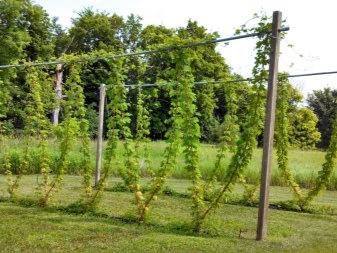
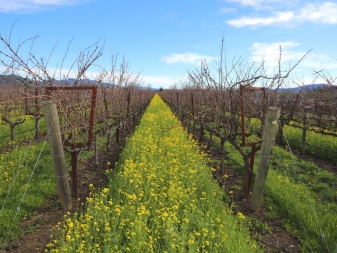
Observing all these simple rules, even a novice gardener will be able to grow healthy and tasty grapes that you can eat yourself or sell on the market.
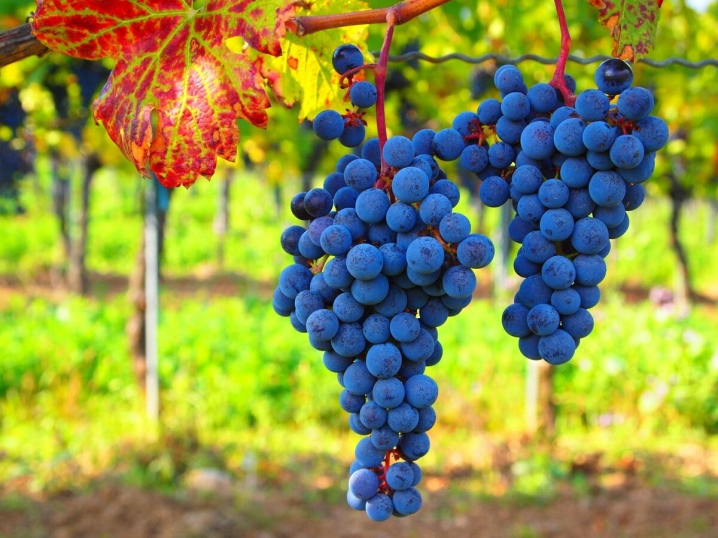
For the prevention of grape diseases, see below.













The comment was sent successfully.